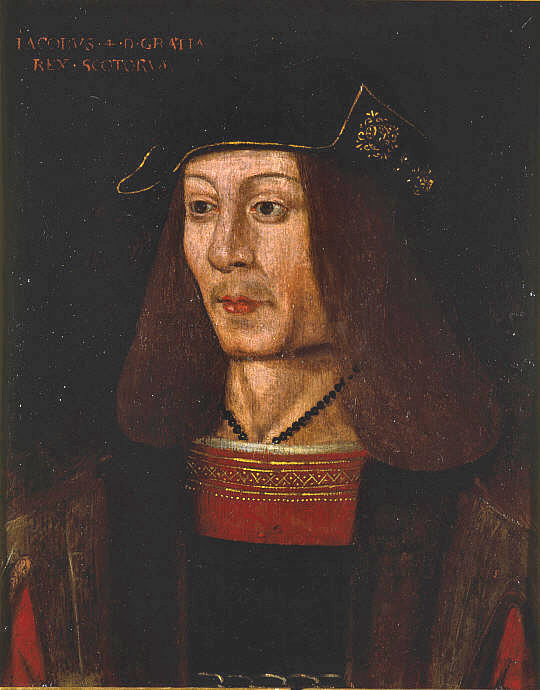
Reign
11 June 1488–9 September 1513
Coronation
24 June 1488
Predecessor
James III
Successor
James V
Spouse
Margaret Tudor
Issue
James, Duke of Rothesay (infant)Arthur, Duke of Rothesay (infant)James VAlexander, Duke of Ross (infant)
James IV (17 March 1473 – 9 September 1513) was King of Scots from 11 June 1488 to his death. He is generally regarded as the most successful of the Stewart monarchs of Scotland, but his reign ended with the disastrous defeat at the Battle of Flodden Field, where he became the last British monarch to be killed in battle.
11 June 1488–9 September 1513
Coronation
24 June 1488
Predecessor
James III
Successor
James V
Spouse
Margaret Tudor
Issue
James, Duke of Rothesay (infant)Arthur, Duke of Rothesay (infant)James VAlexander, Duke of Ross (infant)
James IV (17 March 1473 – 9 September 1513) was King of Scots from 11 June 1488 to his death. He is generally regarded as the most successful of the Stewart monarchs of Scotland, but his reign ended with the disastrous defeat at the Battle of Flodden Field, where he became the last British monarch to be killed in battle.
Early life
Reign
Arms of James IV
James was a true Renaissance prince with an interest in practical and scientific matters. He granted the Edinburgh College of Surgeons a royal charter in 1506, turned Edinburgh Castle into one of Britain's foremost gun foundries, and welcomed the establishment of Scotland's first printing press in 1505. He was a patron of the arts, including many literary figures, most notably the Scots makars whose diverse and socially observant works convey a vibrant and memorable picture of cultural life and intellectual concerns in the period. Figures associated with his court include William Dunbar, Walter Kennedy and Gavin Douglas who made the first complete translation of Virgil's Aeneid in northern Europe. His reign also saw the passing of the makar Robert Henryson.
James was well educated and a fluent linguist. In 1499 the Spanish envoy Pedro de Ayala reported that he was able to "speak Latin, French, German, Flemish, Italian and the barbarian Gaelic, the native tongue of nearly all his subjects"[1]. The king's interest extended beyond aquisition of languages; as part of a language deprivation experiment, James sent two children to be raised by a mute woman alone on an island, to determine if language was learned or innate.[2] [This citation needs checked]
James was a true Renaissance prince with an interest in practical and scientific matters. He granted the Edinburgh College of Surgeons a royal charter in 1506, turned Edinburgh Castle into one of Britain's foremost gun foundries, and welcomed the establishment of Scotland's first printing press in 1505. He was a patron of the arts, including many literary figures, most notably the Scots makars whose diverse and socially observant works convey a vibrant and memorable picture of cultural life and intellectual concerns in the period. Figures associated with his court include William Dunbar, Walter Kennedy and Gavin Douglas who made the first complete translation of Virgil's Aeneid in northern Europe. His reign also saw the passing of the makar Robert Henryson.
James was well educated and a fluent linguist. In 1499 the Spanish envoy Pedro de Ayala reported that he was able to "speak Latin, French, German, Flemish, Italian and the barbarian Gaelic, the native tongue of nearly all his subjects"[1]. The king's interest extended beyond aquisition of languages; as part of a language deprivation experiment, James sent two children to be raised by a mute woman alone on an island, to determine if language was learned or innate.[2] [This citation needs checked]
Marriage
For a time, he supported Perkin Warbeck, the pretender to the English throne, and carried out a brief invasion of England on his behalf. However, James recognized that peace between Scotland and England was in the interest of both countries, and so signed the Treaty of Perpetual Peace (1502) and married Henry VII's daughter Margaret Tudor, on 8 August 1503, at Holyrood Abbey, Edinburgh.
The union produced around six children[3]:
James, Duke of Rothesay, who died at barely a year old
An unnamed daughter, stillborn at Holyrood Palace on 15 July 1508
Arthur, Duke of Rothesay, who died before his first birthday
James V, the only one to reach adulthood
A second stillborn daughter in November 1512 at Holyrood Palace
Alexander, Duke of Ross, born after James's death, and died before his second birthday
Illegitimate children
James also had seven illegitimate children with four different mistresses:
with Marion Boyd:
Alexander, later Archbishop of St Andrews
Catherine Stewart, who married James Douglas, 3rd Earl of Morton
with Margaret Drummond:
Margaret
with Janet Kennedy:
James, created Earl of Moray
two children who died in infancy
with Isabel Buchan, daughter of James Stewart, 1st Earl of Buchan:
Lady Janet Stewart
Later life
Rumours persisted that James had survived and had gone into exile, but there is no evidence to support them.
Legacy
James IV is also significant in Scottish history as the last King of Scots who is known to have spoken Scottish Gaelic.
